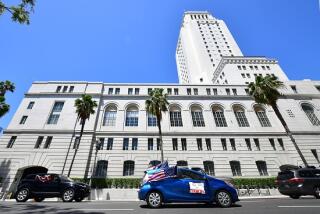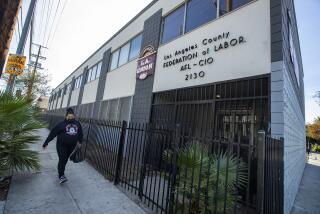A Real-Life Film Noir, Except for the Ending
- Share via
It was Frank Capra meets film noir and it happened, of course, in Los Angeles:
The hero was a courageous, square-jawed teetotaler; the heavy, a bootlicking gunman out to frame the good guy. Though it sounded, even then, like something straight out of the movies, their encounter produced the juiciest scandal ever to rock City Hall.
Councilman Carl I. Jacobson was the champion of impossible causes, a good-government crusader who began his political career with a single-handed attempt to drive an organized crime syndicate out of town.
During the 1920s, Jacobson’s appointment to the 13th District council seat, which became vacant when his predecessor was caught fiddling contracts on the 2nd Street tunnel project, was a ray of hope in a murky civic epoch. Vice, graft and corruption were the city’s normal backdrop, and Jacobson was the beleaguered reformers’ darling.
The honeymoon lasted nearly two years.
The Norway-born Jacobson arrived in Los Angeles in 1909 and went to work as an engineer for Southern Pacific before becoming a high-ranking official with the railroad’s union.
His bumpy rail crossing into politics began in 1925, when he was appointed to fill the vacant council seat. His predecessor, Joseph Fitzpatrick, who had defeated Jacobson by just 12 votes in the previous election, was caught awarding contracts for the construction of the 2nd Street tunnel to a certain mob-connected contractor.
Elated by his new responsibilities, Jacobson openly vowed to expose corruption and rid the city of prostitutes, bootleggers and gamblers.
As a fierce critic of the Los Angeles Police Department’s Central Vice Squad--in those days basically a collection agency for the city’s vice lords--Jacobson made his share of enemies. Albert Marco was one of them, a racketeer, pimp and extortionist, and also an associate of mobster Charlie Crawford, better known as “the Wolf of Spring Street.”
Marco tried to prove to the councilman that he really wasn’t such a bad guy by offering him $25,000, if he would take a bit more interest in parks and recreation and a little less in vice.
The fearless Jacobson not only declined, but also informed the federal government of Marco’s activities, which led officials to fine him $250,000 for tax evasion.
That’s when the real trouble started.
Marco decided Jacobson had to go, and came up with a plan to unseat the councilman. He soon located an ally, Callie Grimes, who was willing to enlist in the effort for a down payment of $2,500 and the promise of a $100-per-month stipend for the rest of her life.
Grimes, a beautiful divorced mother, owned a home in Jacobson’s 13th District. She also happened to be the sister-in-law of LAPD vice cop Frank Cox, who just happened to work for Marco. Shortly after receiving her down payment, Grimes arrived at Jacobson’s office in City Hall to discuss a proposed street assessment on her property at the corner of Beagle Street and Huntington Drive in El Sereno.
On the evening of Aug. 5, 1927, purportedly driven to tears by the burden of the pending assessment, Grimes asked Jacobson to stop by her house to see if these improvements were really necessary.
Unbeknown to Jacobson, four police officers and two newspaper reporters were already parked near the house when he arrived, neighbors would later testify.
Inside, one thing led to another. Soon after the lights went out, the police burst through the front door.
Clad only in his red underwear, with a bottle of whiskey nearby, Jacobson asked one of the officers to lend him his gun.
“I’ll put a bullet in my brain. I realize I’m through,” he said.
The cop kept his gun and Jacobson and Grimes were arrested and charged with lewd conduct.
Encouraged to sign a confession, Jacobson refused and demanded a trial, bitterly denying the charges.
At the trial, he admitted having an “immoral interest” in Grimes, but denied he ever acted upon it. After he refused her offer of a drink, he said, someone hit him on the head, knocking him out.
Grimes, who just happened to be defended by Marco’s personal attorney, took the stand.
“He said he had admired me from the first minute he saw me and that I was a beautiful woman,” she testified. “He talked about ‘dying for love’ and complained because his wife was too religious.”
She said she was pressed for money and that she made love to Jacobson because he promised to take care of her and her little girl.
When the jurors, 11 women and one man, announced that they were hopelessly deadlocked, two nervous jurors collapsed amid charges of jury tampering. But before the second trial began, the charges were dropped.
Under a cloud of controversy, Jacobson remained in office, while Grimes skipped town for a short time with a snake-charmer and $2,500 in her purse.
Then, in 1928, Marco’s empire began to crumble. During a drunken brawl at Ships Cafe, a boat-shaped eatery and speak-easy on the Venice Pier, Marco shot and seriously wounded another patron.
Stuck in jail, Marco was unable to make his monthly payments to Grimes, who recently had returned to town without the snake-charmer or her money. Intolerant of deadbeats, Grimes blew the whistle in 1929, admitting that she helped frame Jacobson. The case was reopened at the same time Jacobson won reelection, and the color of his underwear was once again the hot topic.
Only this time, it was Marco, Crawford, Grimes and five police officers who were charged with conspiracy to frame a councilman. But the result was the same--another hung jury.
Marco stood trial twice on other charges of assault and attempted murder before he was finally convicted and deported to his native Sicily. Crawford, the Spring Street crime czar, was killed two years later by a former deputy district attorney and unsuccessful judicial candidate who was outraged because he had been demoted for prosecuting the mobster’s henchman, Marco. Grimes, meanwhile, left town for good.
Jacobson resigned in 1933 to sell real estate. It may not be the stuff of film noir, but in Los Angeles that’s the way real lives end.
Rasmussen’s new book, “L.A. Unconventional,” a collection of stories about Los Angeles’ unique and offbeat characters, is available at most bookstores or can be ordered by calling (800) 246-4042. The special price of $30.95 includes shipping and sales tax.
More to Read
Sign up for Essential California
The most important California stories and recommendations in your inbox every morning.
You may occasionally receive promotional content from the Los Angeles Times.













